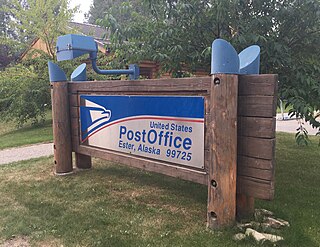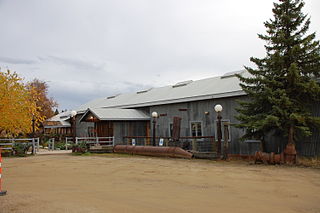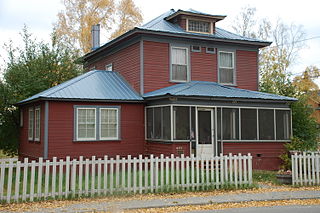
Ester is a census-designated place (CDP) in Fairbanks North Star Borough, Alaska, United States. It is part of the Fairbanks, Alaska Metropolitan Statistical Area. The population in the CDP was 2,422 at the 2010 census, although there are only about a dozen homes in the village itself. The Ester Camp Historic District is a historic district listed on the National Register of Historic Places. Ester was founded as a gold mining camp in the early 1900s, and the economy has focused on mining and services for miners. The Ester Community Association was founded in 1941, and continues to work for the welfare of the community, e.g. establishing and maintaining the Ester Community Park and sponsoring an annual Fourth of July parade. There are several small businesses in Ester, including two saloons, a publishing house, a jewelry maker, hand crafted soap maker and local artisans. The Ester Volunteer Fire Department, John Trigg Ester Library, Ester Historic Society and Ester Post Office serve residents in Ester and surrounding areas. There is also a convenience store and secular chapel on the outskirts of the village. Many artists, writers, and musicians reside in Ester and the local art and music scene has thrived for many years.

Yukon–Charley Rivers National Preserve is a United States national preserve located in east central Alaska along the border with Canada. Managed by the National Park Service, the preserve encompasses 130 miles (208 km) of the 1,800-mile (3,000 km) Yukon River and the entire Charley River basin. The preserve protects the undeveloped Charley River and a significant portion of the upper Yukon. The interior Alaskan region experiences extremes of weather, with temperatures that can vary from −50 °F (−46 °C) in winter to 97 °F (36 °C) in summertime. The Yukon provided a means of access to the region, which is entirely roadless, during the late 19th century and early 20th centuries. Gold rushes in Alaska brought prospectors, who operated gold dredges to recover significant quantities of placer gold from area creeks. Today the preserve includes part of the route of the annual Yukon Quest dogsled race, which runs every February. During the summer float trips are popular on the Yukon and Charley Rivers.

The F.E. Company Dredge No. 4, also known as the Pedro Dredge and the Chicken Dredge, was originally owned by the Fairbanks Exploration Company, a subsidiary of the United States Smelting Refining & Mining Co. (USSR&M). It was built by the Yuba Manufacturing Company in California, and was shipped to Pedro Creek north of Fairbanks, Alaska in 1938. It was assembled there, and operated until 1958.

SS Nenana is a five-deck, western river, sternwheel paddleship. Two-hundred and thirty-seven feet in overall length, with a 42-foot beam, she was rated at 1,000 gross tons register. Nenana was built at Nenana, Alaska, and launched in May 1933. Marine architect W.C. Nickum of Seattle designed the sternwheeler, which was prefabricated in Seattle and put together at Nenana, Alaska, by Berg Shipbuilding Company. Nenana was built to serve as a packet. She could carry both passengers and freight. Nenana had accommodations for 48 passengers on her saloon deck. Up to 300 tons of freight, including two tons in cold storage, could be carried on her main deck. A Texas, topped by a pilothouse mounted forward in poolboat style, provided staterooms for a portion of the crew of 32. Nenana could push five or six barges on the Yukon River; but, because of sharp bends, only one on the Tanana River.
Gold mining in Alaska, a state of the United States, has been a major industry and impetus for exploration and settlement since a few years after the United States acquired the territory in 1867 from the Russian Empire. Russian explorers discovered placer gold in the Kenai River in 1848, but no gold was produced. Gold mining started in 1870 from placers southeast of Juneau, Alaska.

Chatanika is a small unincorporated community located in the Fairbanks North Star Borough, Alaska, United States, north-northeast of the city of Fairbanks. The community runs along an approximately 20-mile (32 km) stretch of the Steese Highway, the majority of which sees the highway paralleled by the Chatanika River. The community consists of sparsely scattered residential subdivisions, several roadside businesses, a boat launch where the Steese Highway crosses the Chatanika River, relics of past gold mining operations in the area and the Poker Flat Research Range operated by the Geophysical Institute of the University of Alaska Fairbanks.

The Coal Creek Historic Mining District is a gold-mining area in the Yukon-Charley Rivers National Preserve of Alaska dating from the 1930s. It features a gold dredge and a supporting community of several dozen buildings, established by mining entrepreneur Ernest Patty.

Goldstream Dredge No. 8 is a ladder dredge operated by the Fairbanks Exploration Company from 1928 to 1959. It is located on the old Steese Highway between Fairbanks and Fox in the central part of Alaska.

Davidson Ditch is a 90-mile (140 km) conduit built in the 1920s to supply water to gold mining dredges in central Alaska. It was the first large-scale pipeline construction project in Alaska, and lessons learned in its construction were applied to the building of the Trans-Alaska Pipeline System. It is eligible for inclusion on the National Register of Historic Places, but has not been listed due to a lack of information. Despite this, the remains of the conduit are partially protected by its inclusion in the White Mountains National Recreation Area.

Creek Street is a historic area of Ketchikan, Alaska. The street is actually a boardwalk mounted in stilts on a high slope on the east side of Ketchikan Creek, east of the city's downtown. Creek Street was listed on the National Register of Historic Places in 2014.

The Chatanika Gold Camp is a historic gold mining camp at Mile 27¾ of the Steese Highway in Chatanika, Alaska. The camp is set on about 49 acres (20 ha) overlooking Cleary Creek, and consists of thirteen buildings as well as a scattering of old mining tools and equipment. The largest of the buildings are two bunkhouses, finished in corrugated metal. The camp was built in 1925 by the Fairbanks Exploration Company (FEC), which also dug the nearby Davidson Ditch to supply water for the operation of the gold dredges. The Chatanika Camp was the largest of the FEC's mining camps in the Fairbanks area. Five of the surviving buildings date to the initial construction period.

The Chena Pump House, also known just as the Pump House Restaurant, is a restaurant at 796 Chena Pump Road in Fairbanks, Alaska. The restaurant is located in the shell of a 1933 pumping station established by the Fairbanks Exploration Company, Alaska's largest gold mining operator at the time. The pump house was used to provide water to dredges operating on Cripple Creek in the Ester area. The building was abandoned by the company in 1958, and was enlarged and converted into a restaurant in 1978. It was listed on the National Register of Historic Places in 1982.

The Mary Lee Davis House is a historic house at 410 Cowles Street in Fairbanks, Alaska. It is now the Alaska Heritage House, a bed and breakfast inn. It is a 1+1⁄2-story bungalow-style house, set at the northern corner of Cowles and 5th Avenue in a residential area of the city. The exact construction date of the house is uncertain: it was probably complete by 1916, but construction may have begun as early as 1906; it is acknowledged as the city's oldest occupied residence. The unfinished house was purchased by writer Mary Lee Davis and her husband, who finished the building and added a number of its distinctive touches, including the city's first residential coal heating system. After a period of ownership by the Fairbanks Exploration Company, during which it was home to company executives, it went through a succession of owners before being converted to a bed and breakfast.

The Discovery Claim on Pedro Creek is a historic gold mining site in central Alaska. It is located at mile 16.5 of the Steese Highway, northeast of Fairbanks. It is a 19-acre (7.7 ha) site on what is now called Pedro Creek, that was where Felix Pedro made the first major discovery of gold in the area on July 22, 1902. His discovery drew large numbers of gold prospectors to the area, and led to the establishment of Fairbanks as a major community in Alaska. Most of the claim site is located south of the highway, which crosses one corner. There is a commemorative marker placed at the side of the highway in 1952. The claim is now owned by the Pioneers of Alaska Igloo #4; there is no substantial evidence of the mining activities that took place there.

The Fairbanks Exploration Company was the major economic force in the growth of Fairbanks, Alaska during its gold rush years in the early 20th century. In the 1920s the company built a number of housing units for its workers. A cluster of at least eight of these is known to have survived on the east side of Illinois Street, of which four have retained historical integrity. Located at 505, 507, 521, and 523 Illinois Street, they are all similarly built Bungalow-style wood-frame buildings, 1+1⁄2 stories in height, with a hip roof and projecting hipped wings. The complex includes a five-stall garage which served all four houses, as well as two greenhouses. At the time of their listing on the National Register of Historic Places in 1997, this group of houses was being rehabilitated for use as a bed and breakfast inn.

The Fairbanks Exploration Company Machine Shop is a historic machine shop in Fairbanks, Alaska, United States. Located behind the Fairbanks Exploration Company administration building at 612 Illinois Street, it is a large single-story steel-frame structure, built in 1927 to serve the company's nearby gold mining operations. Its easternmost section is 16 feet (4.9 m) high, while that on the west is 20 feet (6.1 m) high, in order to accommodate belt-driven equipment and cranes. A tall double door at the center of the east facade is the main entrance. The front of the building housed large belt-driven lathes, while the center had a welding shop, drill presses, and a tool room. A blacksmithy in the back had a sand floor. The building was used by the F.E. Company between 1927 and 1964.

The Fairbanks Exploration Company Manager's House, also known as The White House and the Sisters' Convent, is a historic house at 757 Illinois Street in Fairbanks, Alaska. It is a three-story wood-frame structure, five bays wide, with a side gable roof, clapboard siding, and a post-and-beam foundation. An ell extends from the center of the rear. The house was built in 1935-36 by the Fairbanks Exploration Company to house its local vice president and general manager. It is the first Colonial Revival house built in Fairbanks, and is one of the state's finest examples of the style.
The Fairbanks Exploration Company Gold Dredge No. 5 was a historic gold mining dredge in a remote area of Fairbanks North Star Borough, Alaska, north of the city of Fairbanks. It was last located on Upper Dome Creek, shortly northeast of the mouth of Seattle Creek, about 20 miles (32 km) north of Fairbanks, prior to its being scrapped c. 2012. The dredge was manufactured by the Bethlehem Steel Company in 1928, shipped in pieces to Alaska, and assembled by the Fairbanks Exploration Company on Cleary Creek, where it was used until 1942. It thereafter served on Eldorado Creek (1947–55) and Dome Creek (1955-59) before it was abandoned.

The Falcon Joslin House is a historic house at 413 Cowles Street in Fairbanks, Alaska. Built in 1904, this American Foursquare two-story frame house is the oldest house in Fairbanks set at its original location, and was one of the first frame houses built in what was then a mining camp. The house was built by Falcon Joslin, a Tennessee lawyer who came to Fairbanks and financed construction of the railroad connection to Chena, the head of navigation on the Tanana River. Joslin's railroad ensured the economic success of Fairbanks, which was then competing with Chena as a supply center for miners in the region. In 1930 the house was purchased by Fairbanks Exploration Company, which used it as housing for executives and employees until 1960.

Dredge No. 4 is a wooden-hulled bucketline sluice dredge that mined placer gold on the Yukon River from 1913 until 1959. It is now located along Bonanza Creek Road 13 kilometres (8.1 mi) south of the Klondike Highway near Dawson City, Yukon, where it is preserved as one of the National Historic Sites of Canada. It is the largest wooden-hulled dredge in North America.




















